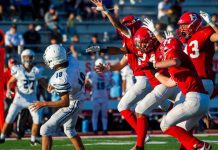
Chris Borland and Dr. Bennet Omalu are right. Within America’s football-infatuated culture—I’m as guilty as anyone—we are all dangerously wrong.
For Borland, the San Francisco 49ers’ formerly promising rookie linebacker, football’s imminent health risks were too obvious to continue playing an ultra-lucrative game he dearly loved. Borland retired in the spring of 2015 after his first NFL season and left tens of millions of dollars in future earnings on the table because he was convinced—through credible scientific study and his own very real experiences—that playing the game properly came with inherent and likely permanent health risks, most notably to his brain.
Omalu is the subject of the “Concussion” movie premiering Dec. 25—Merry Christmas, NFL—and he aptly described in a Dec. 7 New York Times op-ed how the repetitively violent nature of the sport causes serious brain damage in players on all levels and leaves children susceptible to permanent injury. Omalu in the piece argued in favor of banning youth football and provided convincing evidence to support the case.
“If a child who plays football is subjected to advanced radiological and neurocognitive studies during the season and several months after the season, there can be evidence of brain damage at the cellular level of brain functioning, even if there were no documented concussions or reported symptoms,” wrote Omalu, San Joaquin County’s chief medical examiner, for The Times. “If that child continues to play over many seasons, these cellular injuries accumulate to cause irreversible brain damage, which we know now by the name Chronic Traumatic Encephalopathy, or C.T.E., a disease that I first diagnosed in 2002.”
In writing this, Omalu expressed the most important—and often forgotten or dismissed—point in this debate: It is impossible to escape, despite safeguards and fundamentally sound play, from football’s unceasing abuse to the brain.
Omalu and Borland, one of the toughest, most intense football players around—I closely followed his career at my alma mater Wisconsin before the 49ers drafted him—have become two of the most important figures in a movement to inform the public on health risks involved with America’s flawed obsession.
The 24-year-old walked away from the game after his estimate of 30 concussions. It’s a number based on symptoms he learned of in the past year—as recounted in a lengthy ESPN The Magazine piece—during his thoughtful submergence into the involved medical science. For Omalu, science is behind his push to lobby for an outright ban against youth football.
They’re both right—Borland for siding with an assurance of long-term health and trusting his thoughtful convictions, and Omalu for making a case that children are in no place to knowingly endanger their futures—and I’ll tell you why I agree with both of them.
A doctor’s fight
Omalu started his must-read New York Times piece by openly wondering why our culture rightfully restricts youth from partaking in dangerous activities such as smoking and drinking alcohol, or exposing them to asbestos, but we allow them to willfully endanger their health through high-impact sports such as football.
Otherwise, Omalu’s op-ed didn’t play at any heartstrings.
He pointed out that in the past two decades, “it has become clear that repetitive blows to the head” in football, boxing, mixed-martial arts and hockey “place athletes at risk of permanent brain damage.” He described that affected youth could manifest symptoms of CTE such as “depression, memory loss, suicidal thoughts and actions, loss of intelligence and dementia” in later years. He argued that evidence shows how repetitive play of the game at a young age could lead to abuse of alcohol and drugs in a person’s 20s, 30s and 40s.
And Omalu added he is not alone in his belief about youth football’s impacts. The top American and Canadian pediatric associations in 2011 published a position paper “recommending that children should no longer be allowed in high-impact contact sports.”
That’s a staggering assertion from two top national organizations of children’s doctors, but it came out four years ago and we still seem more concerned about who’s performing the Super Bowl halftime show or title aspirations of our local peewee and high school teams than we do about the blunt realities of this war-like game.
Omalu brings a wholly rational perspective, while anyone who has played for any extended period of time also knows there is something harshly irrational about this idea of repeatedly sprinting and lunging toward other people with extreme force while intending to pummel and potentially hurt them.
Borland’s brave choice
Borland jumped out on the TV screen, as typical football broadcasters like to say. At the same time, he was technically sound. He had to be with a 5-foot-11 frame—usually about four inches too short for an NFL middle linebacker—so it wasn’t like he happened upon all those head injuries.
Known for his intellect, Borland absorbed enough information and experience to make a seemingly implausible, abrupt choice for any other Average Joe across America: Quit the NFL dream so he could minimize his own risks for serious, long-term brain damage.
In a 7,600-word ESPN The Magazine story published in August, co-writers Steve Fainaru and Mark Fainaru-Wada—authors of the groundbreaking 2013 book “League of Denial” about the NFL’s morally reprehensible response to the concussion crisis—documented Borland’s realization and rationale behind his decision.
In the story, Borland is quoted as still professing his love for football, but also how his own concerns and literary works such as “League of Denial” spurred further research about the game’s effect on the brain. What he found was damning toward his football future and beliefs about the game’s risks.
As the ESPN The Magazine piece described, Borland met with renowned Boston University neurology professor Robert Stern, who relayed how CTE was found in 87 of 91 dead NFL players whose brains had been examined and told Borland how the 1,000 to 1,500 hits he’d experienced over a decade of football could “manifest” later in life. That day, as Fainaru and Fainaru-Wada wrote for the magazine, Borland retired.
Their story recounted how Borland, in offering himself for research and appearances after his stunning announcement, attended the National Summit on Sports Concussion in L.A.
There, as quoted in the eloquently written ESPN The Magazine story, he had this to say as an interjection after a former Tampa Bay Buccaneers linebacker implored the room of experts to “find ways to make the game safer, better, stronger and more exciting.”
“The game may be safer; you can make an argument about that,” Borland is quoted as saying in L.A. “My experience over my five years at Wisconsin and my one year in the NFL was that there were times where I couldn’t play the game safely. There are positive measures we can take … but on a lead play, on a power play, there’s violence.”
Smash-mouth football
If there’s something I know all too well on this topic, it’s the violence involved on a basic lead power play.
In a traditional I-formation backfield as a fullback in the late 1990s for Brown Deer High School—in a power set with at least 80 percent running plays—my primary job as a lead blocker was to line up behind the quarterback and help the other running back break loose by gaining a head of speed and smashing through a given defender or defenders. Usually my target was a linebacker, and the violent hits—the good ones—often involved a variation of colliding facemasks, cracking helmets or crunching shoulder pads. They were just standard nuances of the game, though, and concussions weren’t ever mentioned outside of now-cartoonish references like getting “dinged.”
Those hits kept adding up on defense, too, in many full-contact practices and nearly 40 games in total through four years. As a two-way player for the relatively small school near Milwaukee, my job on the defensive line in that run-heavy league was to shoot a gap on the interior or rush around the edge while preventing any runners from “breaking contain” toward the sideline, as football people describe. For the most part, when done correctly, that role also involved a high repetition of jarring hits with linemen, running backs or both.
I’m now convinced, through undeniable logic and an acceptance of advances in science, that the many non-concussive hits I absorbed—somewhere well past 1,000—may have accumulated to cause damage.
My first of at least a half-dozen stingers—experienced a few games into senior season while tackled on a run play up the middle—was a wake-up call about football’s fundamental risks.
A stinger is a lot worse than it sounds. It’s an injury to nerves in the neck and spinal cord area and causes temporary loss of feeling to extremities. In my initial experience, the collision caused the ailment’s typical shooting pains down my right arm and severe numbness on that same side of my body. At first, not knowing what had happened, I lay motionless wondering about the worst, paralysis, until a sense of feeling gradually returned to those areas.
Athletes typically walk away fine. For me, however, more of them occurred in a wave over a period of three or so games—as best I recall—with multiple, definitive stingers in at least one of those contests. Fortunately, the school trainer at the time noticed my limp arm after a second stinger in a single game and warned that another meant I’d have to sit. Unfortunately, I was an ill-advised 17-year-old, sustained at least one more stinger in that game and avoided telling the trainer. When they continued happening, though, my family had an MRI done that failed to detect any serious damage in those nerves at the time. So of course, I continued playing and the team merely slapped one of those giant neck rolls to my pads.
As the season went on, something else oddly alarming happened. After every game in a stretch lasting at least half of the schedule, I would go home and face what became inescapable: the night spent violently ill and throwing up with severe headaches and nausea—symptoms now known as typical to concussions but something I passed off at the time as a consequence of exertion.
I didn’t have any concussions diagnosed in high school so I’ll never know for sure, but I did at age 10 after falling from a bicycle without a helmet and hitting my head on pavement, causing a blackout. I had another textbook concussion in college playing a friendly game of, all things, recreational flag football on an attempted dive into the end zone.
Occurrences like those could bolster others’ argument—that all sports and physical activities come with inherent risks—and I appreciate that.
Hypocrisy is also something I can’t ignore in supporting the case to ban youth football. I truly loved the game, had the chance to enjoy its indescribable thrills and even had a handful of offers from small schools to continue playing in college. It provided me with opportunities I wouldn’t have otherwise experienced.
Those benefits are undeniable. So are the realities that football is a barbaric, violent, dangerous activity.
For parents, with better science and more information over time, it is incumbent to research the subject and make an informed decision. For a contemporary society, continuing to ignore the alarm bells on something so worrisome—destruction of the human brain in mass quantities—is utterly reckless.
MORE ONLINE
“Don’t Let Kids Play Football”
“Why former 49er Chris Borland is the most dangerous man in football”
“Frontline: Concussion Watch”









